Introduction
Due to the importance of the English language as a means of international communication, in 2012, Ecuador created the National English Curriculum Guidelines which describe the English level that must be achieved during each academic year. Secondary education has a total of six years, so by the end of each year, each of these levels is supposed to be acquired A1.1, A1.2, A2.1, A2.2, B1.1, B1.2. In that way, the Ministry of Education of Ecuador has to guarantee that high school graduates reach a minimum B1 level of proficiency in the English language, according to the Common European Framework of Reference for Languages (CEFR), in all regions, provinces, and cities of our country (Ministerio de Educación, 2019). However, this does not happen in the Amazon Region. After applying a placement test to students who started college, results showed that almost 60% of them had achieved A1 level (the placement test used was the Interchange-Passages Placement Testing Program by Cambridge University Press, and it is applied to all students starting their first year of study at university). Besides, Ecuadorian students are not willing to read complete books in English. Their limited command of vocabulary forces them to constantly translate terms, reducing reading comprehension and, therefore, reducing interest as well. This shows the need to develop and reinforce all English language skills, especially reading-comprehension skills and reading habits.
To overcome these challenges in language learning, a practical strategy that can be used is called literature circles (Daniels, 2002; Moeller & Moeller, 2002; Shelton-Strong, 2011). Literature circles is a strategy that engages students in collaborative group work and individual tasks in order to examine a book in depth, develop language skills, and think critically about texts (Hill et al., 2001). This method has already been used in many educational settings for several years because of its benefits. Research shows that literature circles encourage independent and collaborative learning (Shelton-Strong, 2011), promote student self-determination (Blum et al., 2002), develop enthusiasm for reading (Whittaker, 2012), allow students to be exposed to multicultural views and perspectives (Coles-Ritchie, 2013), and even help to provide scaffolding to students with special needs (Anderson & Corbett, 2008). However, students in the Amazon Region of Ecuador have not been exposed to this strategy. This occurs because English as a Foreign Language (EFL) students in this region are traditionally exposed to a methodology that is mostly based on the memorization of vocabulary and grammar and does not encourage critical reading, questioning, or in-depth text analysis (Kim, 2003; Ortega & Auccahuallpa, 2017).
In general, very little has been written about the use of literature circles in Ecuador. However, the incipient research conducted on this topic confirms the success of using this strategy as a stimulus to foster English written abilities in Ecuadorian universities (Villafuerte Holguin et al., 2017). Nevertheless, in the Amazon Region specifically, there is no written account of the introduction of this strategy. For this reason, research needs to be conducted in order to bridge that gap in academic literature. The purpose of this action research study, therefore, is to explore the impact that the implementation of literature circles has on EFL university-level students in Ecuador. In this study, EFL college students in Ecuador participated in a literature club project that emphasized reading for critical thinking and the development of language skills, including some self-selected readings and cooperative work.
Literature Review
Reading groups and book clubs have been quite a popular practice for many years. They have been so effective that teachers have eventually decided to implement these activities as a teaching strategy in their classes. In the 1980s, Kathy Short and Gloria Kauffman gave these school book clubs the name of “literature circles” (Daniels, 2002). Literature circles are small reading groups that allow students to understand, analyze, interpret, and hold meaningful discussions about a book (Scott, 1994). Participating in a literature circle implies compliance with certain demands. For instance, all students are responsible for reading a section of the target book. They are assigned roles and have to complete an assignment depending on the role given. The most common roles are: a) summarizer: writes and explains the summary of the text; b) predictor: guesses what will happen next in the story; c) connector: makes connections between the passage read and real-life situations; d) vocabulary manager: chooses new vocabulary words and defines them; e) illustrator: creates a drawing that represents the section of the story read; and f) questioner: creates deep questions that promote discussion and analysis of the story (Furr, 2007). The tasks of the designated roles have to be completed individually before meeting as a group. Then, the groups meet periodically to analyze and discuss the section of the story assigned and to share the ideas they have prepared depending on the role they had for that session since the roles are switched among team members every week. In literature circles, students can choose books and groups, and when books are finished, they can form new groups and choose new stories. The purpose is to have open, natural conversations and enjoy the activities developed. In this case, it is important to mention that teachers are only facilitators and evaluators, not members of the groups or instructors (Maher, 2013). Even though planning and developing these activities requires time and effort, literature circles contribute to improving students’ reading and writing skills, as well as their vocabulary (Daniels, 2002).
Literature Circles in EFL classes
In EFL classes, literature circles allow students to have meaningful and real discussions about literature in English, and to break the language barrier (Sambolin & Carroll, 2015). In this type of context, it might be necessary for teachers to select the books and create groups based on students’ needs (Lin, 2002). In some cases, instructors may also see the need to “fill in some of the gaps in students’ understanding” (Furr, 2003, p. 2), especially since they are reading in a language different from their mother tongue. Studies concerning literature circles in EFL settings report both benefits and challenges.
Benefits
Literature circles provide learners with the opportunity to practice the target language in a practical way. When implemented in EFL classes, they contribute to developing communicative competencies in a second language, as well as skills like writing, spelling, and listening comprehension (Bedel, 2016; Kim, 2003). In addition, this activity increases the students’ ability to interpret, analyze, and critically evaluate texts (Bibby & McIlroy, 2013; Brown, 2003; Shelton-Strong, 2012). As it is shown in multiple studies, for example, Bedel (2016), Graham-Marr (2015); Lubis & Rahmawati (2019), Stabile (2009), Su & Wu (2016), Varita (2017), among many others, after applying this activity, these are in general the results reported: students feel motivated to read in their spare time, become more confident when speaking English in public, create links with their classmates, and develop their autonomy since they direct their own learning, make decisions, and take responsibilities. For instance, research conducted in Taiwan with EFL college students demonstrated that learners exposed to literature circles had a higher interpretative comprehension of texts than those who did not use this strategy (Shen, 2013). Another study carried out with EFL students at the university level revealed that students refined their language skills, improved their language production, and started to take ownership of their learning process (Kim & Quinn, 2013).
These results are consistent with some important concepts regarding language learning. For example, Krashen (2004) stated that students need meaningful and authentic input in order to increase their language skills. Constant communication using the target language and vocabulary recycling are the key to success when learning a second language. Additionally, according to Vygotsky’s (1978) Zone of Proximal Development, students are able to fully understand and make sense of a text only when they discuss and analyze a text collectively. Thus, literature circles bring important benefits to EFL classes. However, implementing this activity also presents several challenges.
Challenges
Literature circles are supposed to include dynamic and enthusiastic discussions; nevertheless, depending on student participation and motivation, they can become monotonous, repetitive, and boring (Medina, 2013). In other cases, students tend to use their mother tongue instead of the target language during discussion time, do not read, or do not complete their independent assignments (roles) as required (Furr, 2003). Sometimes, teachers even have to deal with conflicts that emerge among team members (Clarke & Holwadel, 2007). All these situations affect the development of the literature circles and, consequently, the results obtained at the end.
Methodology
Context and background
This study was carried out at a state university in the Amazon Region of Ecuador. This is one of the two higher education institutions available to students in this region (La educación superior es una urgencia en la Amazonía, 2018). It is located in Napo Province, close to a living laboratory of animal and plant species, which attracts students from all over the country wanting to major in science programs. As part of each career profile, students who enroll in this university are expected to learn a foreign language and achieve the level of English required by the government. According to the National Council of Higher Education, “in the third level degree programs, proficiency in the management of a foreign language will be at least the level corresponding to B1 of the Common European Framework of Reference for Languages” (Consejo de Educación Superior, 2019). To respond to such a policy, the university offers a mandatory six-level English language course.
Research design and motivation
Questionnaires administered to the research population (see Appendix 1) revealed that approximately 54% of students had never read a book in English during their EFL instruction in high school. These outcomes motivated us to introduce the literature circles strategy in our lessons in 2016, incorporating into the curriculum the study of books, going beyond the government's requirements and, engaging students in the experience of reading. The method used in this study was action research to understand the perceived impact that implementing literature circles into the college curriculum had on students.
Research questions
- What outcomes and effects will be obtained from implementing the literature circles as a teaching-learning strategy in the English language classes?
- What possible benefits do students perceive this strategy could bring them?
- What challenges do students face when implementing this strategy in their EFL classes?
- What recommendations can be made to those who want to implement Literature Circles in the English Classes?
Timeline of the study and participants
This study was conducted during four college semesters from October 2016 to August 2018. The participants of the study were twelve groups of students—a total of 214 participants. Participants´ ages ranged from 18 to 28 years. The intervention with each group lasted one semester (See Table 1). These classes were EFL classes from levels 2 to 6, and the regular instruction in these classes included the four skills: reading, writing, speaking, and listening, as well as grammar and vocabulary. In this case, the literature circles were included especially as a reading component.
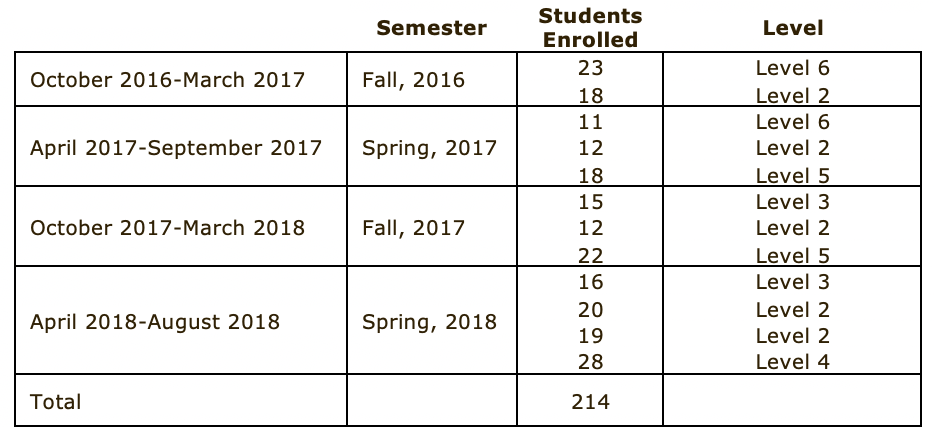
Table 1. Number of students considered as the purposive sample over four semesters.
Literature Circles in action
In this study, two researchers acted as teacher-researchers, while one was an observer. In order to lead students to fulfill all the necessary steps for learning how to get involved in the literature circles, the teachers explained to students all about the literature circles at the beginning of the semester. This explanation involved the objectives, the roles, and the participation in weekly sessions. Teachers allowed students to form groups of five members each. Therefore, in most of the cases five roles were distributed and played, (question director, summarizer, vocabulary enricher, illustrator, and connector). Students completed the literature circles every two weeks during the semester (sixteen weeks in total). They had to switch roles for every assignment and the teacher was the one in charge of assigning new roles every time. The roles were changed so that all students would eventually cover all the roles.
During the activity, students had the opportunity to choose their preferences from about fifteen different options of books (readers), some of which were printed while others were available digitally. Teachers helped students choose suitable books to read, depending on their level of English proficiency. Students were responsible for dividing the book into an equal number of chapters for each session, so that they could complete all of the book in eight weeks, if it was a short book, or sixteen weeks, if it was a long book (See the list of books available for the participants on Appendix 2). Thus, in general, they read two chapters per session until they completed all of the book. After that, each student prepared his/her role independently and brought the written assignment to the classroom meetings. A literature circle session generally lasted for approximately 30-40 minutes. Consequently, each student had to present what he or she wrote for his part/role. During the semester, they would complete one long book or two shorter books.
Data collection: Instruments and processes
The teacher-researchers prepared a written informed consent for each participant (See Appendix 3); this consent was explained prior to starting the activity each semester. Those students who wanted to participate, filled out and signed the informed consent. Although all students participated in the literature circles activity since it was part of the class planning, only those who were willing to take part in the study, participated in the data collection process (survey and interviews). In order to collect data, we developed two instruments: an attitude Likert scale survey (Appendix 4), which required students to respond to a series of statements by indicating whether they strongly agreed (SA), agreed (A), were neutral (N), disagreed (D), or strongly disagreed (SD) and to respond to two open-ended questions, and an interview (Appendix 5) for those students who were willing to provide further information. This interview gathered information about the students’ perception of the literature circles strategy, including students’ (a) description of the experience, (b) personal opinion about the most valuable parts of the activity, (d) description of the challenges and downfalls experienced when doing the activity, and finally, (c) the overall/general opinion about the literature circles strategy. The survey and the interview were in students’ first language (L1), which was Spanish, since the main objective was to gather authentic and precise information; however, for the comprehension of the study, the instruments are presented here in English.
Results
The study aimed to explore the impact of implementing the literature circles with EFL college students at a university located in the Amazon Region of Ecuador. The goal was to find out the possible benefits as well as challenges and downfalls of the implementation of this strategy in regards to the development of students´ language skills and other skills such as cooperative work and critical thinking skills. Below are the results obtained in the survey:
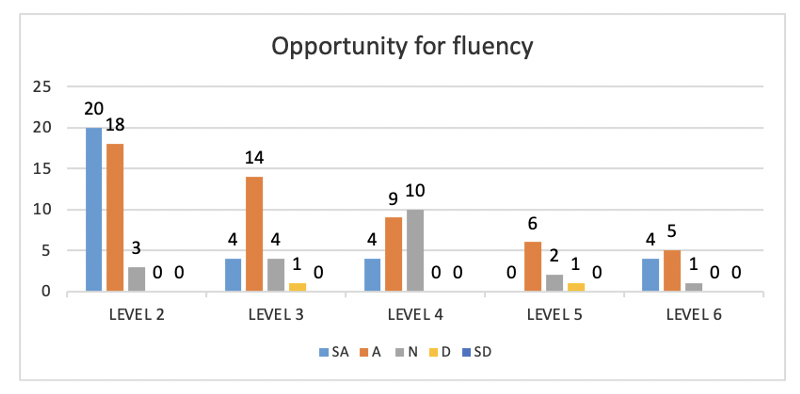
Question 1: Using the Literature Circles activity in the English class has given me more fluency when I speak in English (Strongly agree / Agree / Neutral / Disagree / Strongly disagree).
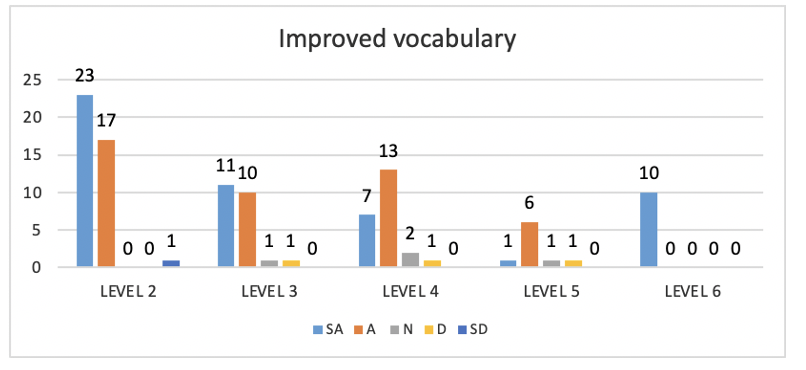
Question 2: Using the Literature Circles activity in the English class has increased my vocabulary in English (Strongly agree / Agree / Neutral / Disagree / Strongly disagree).
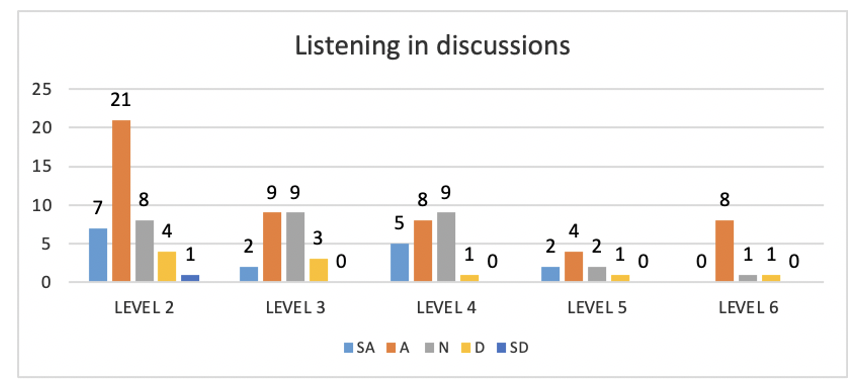
Question 3: Using the Literature Circles activity in the English class has developed my skills to listen to the English language (Strongly agree / Agree / Neutral / Disagree / Strongly disagree).
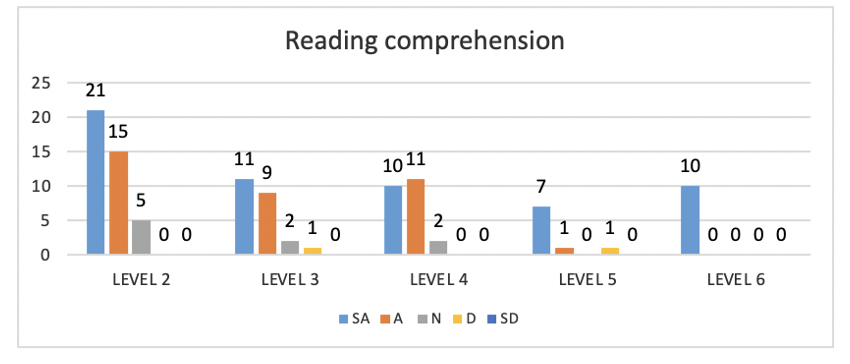
Question 4: Using the Literature Circles activity in the English class has contributed to improving my understanding of texts in English (Strongly agree / Agree / Neutral / Disagree / Strongly disagree).
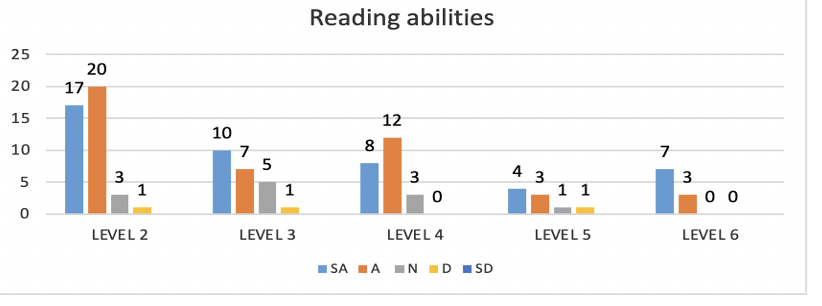
Question 5: Using the Literature Circles activity in the English class has helped me improve my reading skills (prediction, identification of main and minor ideas and characters, inferring meanings, etc.) (Strongly agree / Agree / Neutral / Disagree / Strongly disagree).
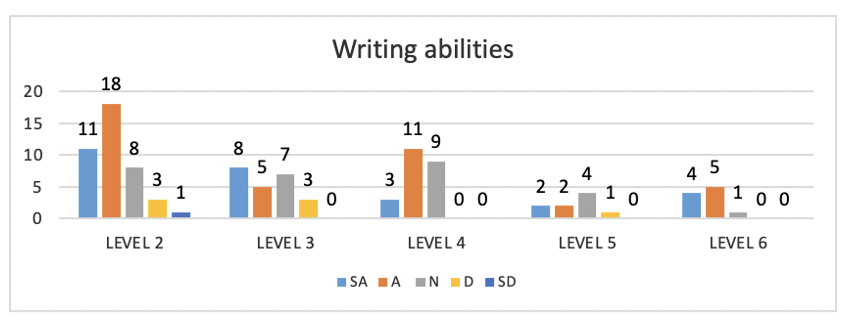
Question 6: Using the Literature Circles activity in the English class has helped me become a better writer in English (Strongly agree / Agree / Neutral / Disagree / Strongly disagree).
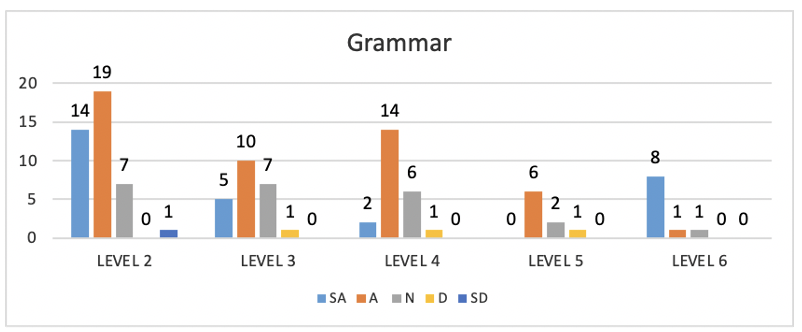
Question 7: Using the Literature Circles activity in the English class, my English grammar has improved (Strongly agree / Agree / Neutral / Disagree / Strongly disagree).
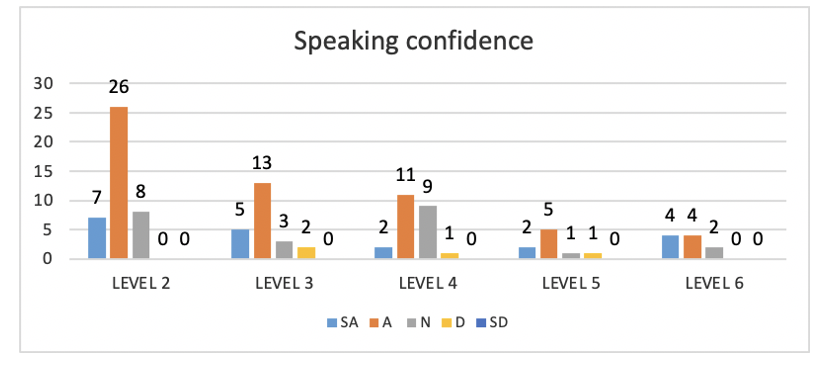
Question 8: Using the Literature Circles activity in the English class has given me more confidence when I speak in the English language (Strongly agree / Agree / Neutral / Disagree / Strongly disagree).
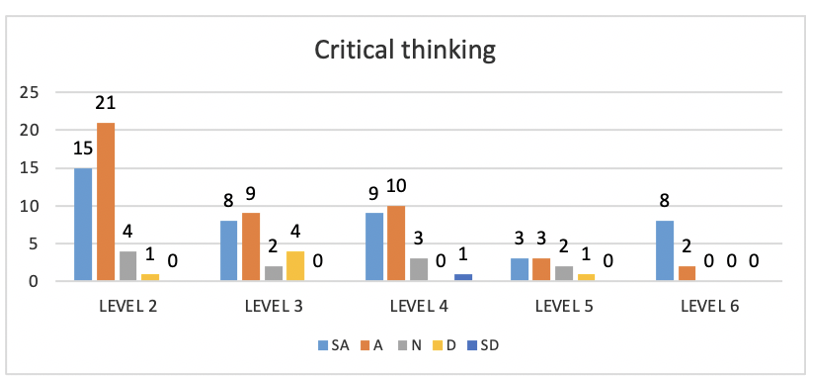
Question 9: Using the Literature Circles activity in the English class has developed my critical thinking skills (analyze, compare, reflect, question, debate, comment, contrast, establish similarities and differences, etc.) (Strongly agree / Agree / Neutral / Disagree / Strongly disagree).
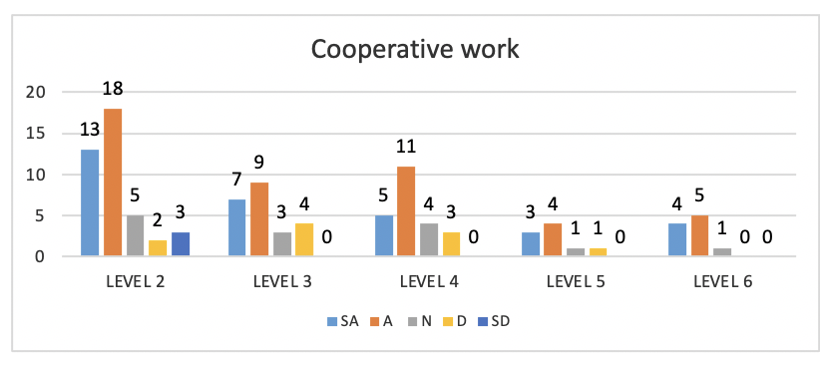
Question 10: Using the Literature Circles activity in the English class has motivated me to work cooperatively (Strongly agree / Agree / Neutral / Disagree / Strongly disagree).
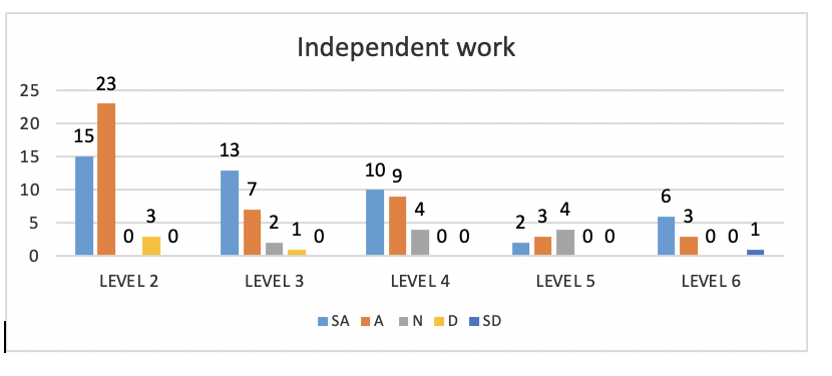
Question 11: Using the Literature Circles activity in the English class has helped me to be more responsible with my independent work (Strongly agree / Agree / Neutral / Disagree / Strongly disagree).
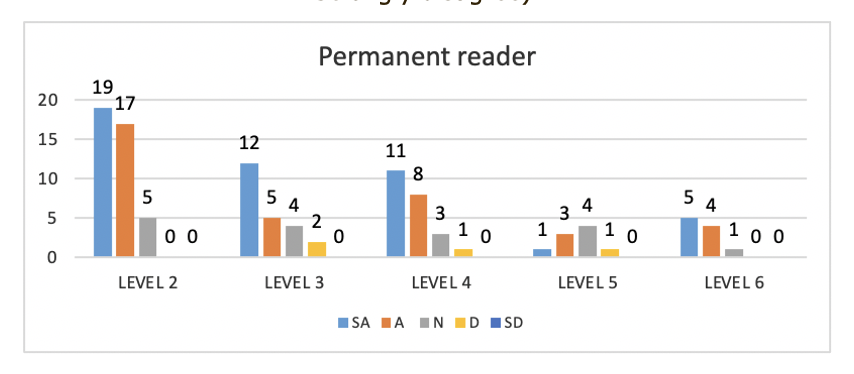
Question 12: Using the Literature Circles activity in the English class has helped me to appreciate the importance of reading for my personal and professional life (Strongly agree / Agree / Neutral / Disagree / Strongly disagree).
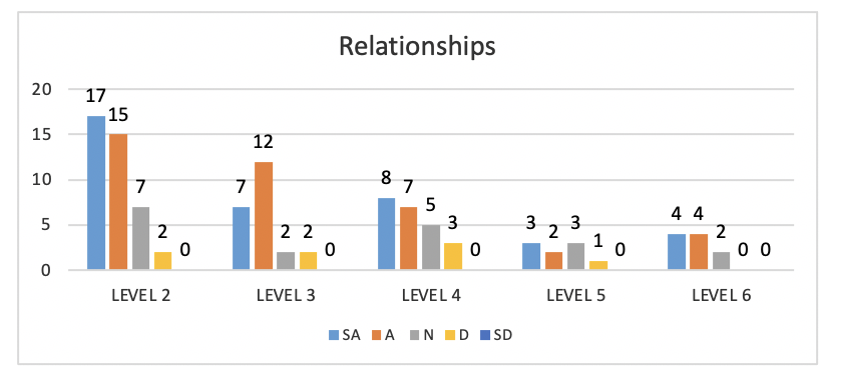
Question 13: Using the Literature Circles activity in the English class has contributed to creating new social relationships (Strongly agree / Agree / Neutral / Disagree / Strongly disagree).
The graphs above indicate that the activity of the literature circles did have an impact on students. In general, most of them answered that they agreed or strongly agreed that this activity had helped them improve in several areas: fluency, vocabulary, listening in discussions, reading comprehension, writing, grammar, speaking confidence, critical thinking, cooperative work, independent work, becoming permanent readers, leadership, and even relationships. Of course, there were students who felt differently, and those answers and the reasons for those answers will be better understood and explained with the open-ended survey questions and the interview questions that will provide further information.
Now, it is interesting that at all levels there was a considerable number of "neutral" responses as to whether the activity helped them improve their grammar and their relationships. There may be several reasons for this, but in principle this activity promotes the communicative use of the language without giving special emphasis to grammar. During the activities, more emphasis was given to communication than to correctness. The goal was for students to be able to share and understand both written and spoken ideas beyond using correct grammar. When reading books, grammar can be improved implicitly rather than explicitly; however, grammar was not one of the strongest points to be developed during this activity.
Another activity in which there was a considerable number of neutral responses is the one about improvement in "relationships". In this regard, the open-ended questions of the survey as well as the interviews helped to understand this further. As explained in more detail in the following sections, teamwork implies challenges. Not all students in the groups carried out the activity with the same level of responsibility, which, in some cases, caused tension or discomfort in some of them.
Finally, it is necessary to mention that in the areas of fluency, listening in discussions, writing, and speaking confidence, in contrast to all the other levels, in level 4, most of the answers were "neutral". There are many possibilities as to why this happened although the interviews and open-ended survey questions did not indicate anything specific or different that occurred at that specific level. Nevertheless, we can say that, although the activities and instructions were carried out similarly in all the levels, there are many factors that could have changed, including having a different teacher, the degree of motivation of the students in a specific course, the level of engagement that the students had with the books read, the level of responsibility with which each student and each discussion group carried out the activity, among others. All these factors could have affected the results in that specific level.
In order to better understand these results, it is necessary to analyze what was found in the open-ended questions of the survey as well as the interviews as presented below.
Survey Results: Open-Ended Questions
The two open questions included in the survey conducted in this study yielded the following results:
Open-Ended Question 1: In your personal opinion, what are other benefits you have gained from doing this activity? Please explain.
The surveys reported several benefits of implementing literature circles. The first benefit was related to vocabulary. Literature circles helped students to learn new vocabulary and use it correctly in different contexts. The readings exposed participants to new words they could use, apply, and practice when writing summaries or doing group discussions. In regards to reading, the participants expressed that they improved their reading skills, enhanced their comprehension of typical forms of expression in English that differ from Spanish, learned how to analyze texts in English, and developed their abilities to understand the hidden messages that authors want to convey behind their stories. For example, one of the learners wrote:
This activity has helped me to improve my reading comprehension of texts in English, have more strategies to evaluate what I have learned in the readings, understand the author’s messages, and develop new strategies to understand books in English.
The third benefit is associated with writing. Learners informed that this activity taught them how to use correct grammatical constructions, develop well-structured paragraphs, use their own words when writing, synthesize ideas, and express them in short and clear summaries. A student explained:
I have learned to synthesize the main ideas of reading. Now I can summarize an entire story in a few sentences.
The next benefit was connected to speaking. Through group discussions, students improved their pronunciation and fluency. A student summarized all these benefits with the following comment:
This activity was really interesting because it helped us to analyze and synthesize ideas, understand stories, and speak English fluently. Now I am doing things like writing and having conversations in English, which I could not do before.
In addition to the benefits related to language development, the surveys also reported other types of advantages as well. For instance, students who participated in the research developed strong bonds with their team members, which created a mutual trust that allowed them to share ideas and support each other when one of their fellows struggled to understand the readings or express their ideas in English during group discussions. A participant shared the following comment:
The literature circles allowed us to create strong relationships with our classmates; therefore, we felt comfortable sharing ideas and correcting each other’s mistakes.
Despite the challenges, most students also learned to work as a team and showed the responsibility and commitment required. A learner explained:
This activity has helped me to be aware that teamwork requires a lot of responsibility.
Another advantage is that literature circles motivated students to value the importance of reading for personal and academic growth. After applying this strategy, students reported they were interested in continuing to read books in English and, little by little, choosing longer and more complex stories. Thus, in some cases, the activity promoted the habit of reading. In addition, literature circles helped students become more creative because they had to develop their imagination by predicting stories and connecting fiction with real life. Finally, participants who used this activity became more patient with themselves and with their learning process because even though the activity was not easy at the beginning, they did not quit, but kept working hard. For example, a student wrote:
I have learned to be patient with myself because I am not good at English, but, with effort, I have improved my language skills and I have learned new things.
Despite all these benefits, learners who used literature circles also experienced some important challenges.
Open-Ended Question 2: In your personal opinion, what challenges have you encountered when doing this activity? Please explain.
Findings revealed that the biggest challenge students faced when using literature circles was to fully understand a story in a different language. According to the participants, it was difficult to understand the meaning of some vocabulary words, especially when they had multiple definitions because it was complicated to know the meaning applied to each case. For instance, a participant stated:
It was difficult to understand some words that were written in the context of a specific place, epoch, or culture that we were not familiar with.
Another student wrote:
I had to use the dictionary a lot because I needed to understand the vocabulary words in order to understand the story.
This was an important issue, especially for those students who, despite recommendations, chose a book that was way beyond their current English level. Another significant challenge was team responsibility. Students found it hard to organize their groups and coordinate the activities due to the lack of cooperation, coordination, or responsibility of some members of the team. One of the participants explained the reason for this problem:
We had a lot of tasks to do at the university and it was difficult to organize our time to read and complete the individual assignments (roles).
Lamentably, when one of the team members was not responsible for their assignments, the whole group suffered.
Some students reported that they struggled with pronunciation and fluency, and experienced problems organizing and connecting thoughts coherently in their minds before sharing them aloud, or felt they lacked enough vocabulary to express clear and full ideas in English. As a result, their classmates could not easily understand the ideas they were trying to share. For example, a student wrote:
I don’t like when I listen to my classmates because some of them don’t use grammar correctly, and it is difficult for me to understand what they say.
Finally, the last challenge was creativity. For some participants, it was difficult to be creative when predicting, drawing, or connecting stories to personal or real-life situations, although this was not reported as a major issue.
Interview Results
The following are the results obtained in the interviews:
Question 1: Describe your experience using Literature Circles in the English class.
The responses to this question varied significantly when comparing lower and higher levels.
Lower Levels (2nd - 4th)
Interviews revealed that students considered literature circles an interesting, useful, innovative, didactic, dynamic, enriching, and gratifying experience that helped them to improve their English skills. These are some examples of the comments received:
It was a different way to study and learn English. I really liked it because we had to read books that were short and adapted to our English level.
I have never had a similar learning experience before. It helped me a lot because all the roles contributed to improving our language skills.
In general, the benefits reported were that students could increase vocabulary, learn typical expressions in English, improve writing (structure and organization of ideas), enhance reading and listening comprehension, develop critical thinking, and overcome the fear of speaking in English. As a student explained:
It is a good start because little by little, it makes it easier to understand complex texts in English.
However, not all students saw the benefits from the very beginning. For some who had never read books in English before, the activity was difficult at first. The following three comments agree on that:
At the beginning, it was hard to understand the vocabulary words and the ideas, but it improved with time.
At the beginning, it was complicated because I have never read books in English before, but then, I started to like it little by little because it is a different way of learning English.
At the beginning, I felt a lot of pressure, but with time, it helped me to have more confidence in my grammar and speaking.
Learners also explained they valued the strong bonds they created with their peers. For instance, they said:
At the beginning, we didn’t have the confidence to talk in front of our classmates, but it ended up being fun, and we even made jokes.
I really liked to work with my classmates. This is the only class where we do that.
Nevertheless, teamwork was not a good experience for all. Most participants said that, even though they liked the activity a lot, working in groups was a real challenge because it required a lot of cooperation among team members. For example, a student explained:
I like the part of reading the book; however, when you have to work in a group, you depend on those who work with you. If the members of your team are not responsible and don’t do their part, you cannot rely on them, and that is stressful and frustrating.
Higher Levels (5th – 6th)
All the higher-level students interviewed described their experience using literature circles in the English class as positive. For example, they said:
It is great because you learn with a new method that is not common.
It is a ludic way of learning, practicing, and presenting what we have read, and we can even learn new words!
In addition to improving their language skills, overcoming stage fright, and bonding with their classmates, the students also valued that they could share their experiences and thoughts and at the same time listen to their classmates’ perspectives, learn from those different perspectives, and get to conclusions as a group. One of the students expressed:
I liked it because each person imagined and predicted something different for each chapter; thus, we could share different perspectives.
Interviews also showed that the students developed critical thinking skills and analysis because they had to understand the book and its context, analyze and recognize the message the author was trying to share, and, finally, express the conclusions reached to the team. These students even liked the illustrator role. They thought it was fun to imagine what was happening in the story and representing it in a picture.
Question 2: In your personal opinion, what is the most valuable part of having worked with Literature Circles and why?
Findings revealed that the most valuable activities were reading, class discussions, and writing (summary). The participants reported that reading books improved their comprehension of texts in English and their ability to analyze and interpret complex stories. For instance, this is what some learners said:
I don’t need to translate word by word anymore; now I can understand the general idea of the text and make sense of what I read.
Reading a book in English is like talking to an English speaker, it helps me to think in English.
Reading has also helped students learn how to structure stories in English and how to use grammar correctly. Regarding this benefit, a participant expressed:
Now I understand how to assemble sentences and paragraphs better.
In addition, this activity expanded and reinforced students’ vocabulary, which facilitated their comprehension of texts and their communication skills. A student said:
I’ve learned to investigate and use the dictionary correctly to find the most appropriate meaning for each word, depending on the context in which it is being used.
As a result of this increase in vocabulary, participants also became more fluent because they had more words to express their ideas and they already knew how and when to use those words. These were some of the comments received:
Knowing more vocabulary allows me to express more varied, not repetitive ideas.
With the new vocabulary learned, now it is easier to express ideas when speaking.
As a result, this generated in students the desire to continue reading books in English.
The class discussion was also reported as one of the most useful activities. Class discussions helped students express their ideas and thoughts fluently, develop their confidence to talk in public, and overcome the fear to pronounce and speak in English. This is what the participants expressed:
We practiced a lot of speaking, so we improved it.
To learn a new language, we have to use it, and the discussions forced us to do exactly that: speak more and fluently.
Another benefit is that when students speak in English in front of their classmates, they can corroborate if others can understand what they are saying and if their pronunciation is correct and understandable. Besides, since the activity required interaction and conversation, everyone had to talk and debate, which strengthened their speaking skills.
Students also enjoyed working in teams because they could improve their abilities to socialize and work cooperatively, learn how to coordinate activities and communicate with people who have different ideas and perspectives, learn how to start and maintain meaningful conversations with their peers, and develop strong bonds with their classmates to correct each other’s mistakes. Students said:
To complete the assignments, it was necessary to interact, work as a team, and communicate with the team.
Each person had a different way of understanding the story; thus, working in groups taught us to understand and accept perspectives and opinions different from ours.
Interview findings also indicated that writing the summary taught students how to synthesize ideas, structure and connect sentences in English, express ideas in another language, and summarize stories in their own words applying new vocabulary words and grammatical structures learned. The following comment exemplifies the importance of this activity:
The most valuable part for me was the summary because you have to read over and over until you understand the text very clearly to write the summary in our own words. It covers everything and demonstrates you have understood what you read.
In addition, there were also a few comments regarding the importance of discussion questions whose objective was to promote debate, discussion of personal opinions and perspectives, and a deeper analysis of the information read. Regarding these questions, students considered that they promoted critical thinking, going beyond what was written in the stories, and understanding the message behind them. When talking about critical thinking, it refers to the personal analysis and judgement of situations posed to discuss. For example, students had to analyze and judge what the characters in a story decided or did, express if they agreed or not with their decision or behavior, explain what they would have done in a similar situation and why, trying to reason and support their argument.
These discussion questions also contributed to understanding the stories better because they prompted the analysis and discussion of texts. The section called “connections” helped students find important lessons and values from the stories read that could be applied to their real lives. Finally, the illustrations improved students’ imagination. For those students who love art, this was an opportunity to capture the story read in a good drawing.
Question 3: In your personal opinion, what is the least valuable part of having worked with Literature Circles and why? [1]
Most students agreed that the least valuable part of the literature circles was the illustration. Even though the participants needed to read and understand the story very well in order to draw a good illustration, some learners felt this activity was not useful to learn English because it did not require much use of the target language since it did not involve an interaction or oral or written presentation of the information read. Besides, many did not like and were not good at drawing, so they did not take this task so seriously. Some students admitted:
You don’t practice English doing the drawing, and I don’t know how to draw, so I always asked someone else to do it for me.
I didn’t know what to draw so I ended up drawing the same over and over again.
Interview results also revealed that participants considered prediction and connection to be less valuable and interesting than other sections of the activity. For instance, the students said:
What is the point of predicting if then I am going to read what really happens in the story!
Writing the prediction and connection doesn’t really help if you cannot express the ideas in your own words and you have to use a translator.
Students also found these sections challenging because they required critical thinking, creativity, and good use of the target language. Some participants expressed:
Predicting is difficult because you don’t know if what you foretold will be similar or different from what the book will say in the next chapter.
It is hard to write the connection because for doing that, you need to understand the text in depth and have a strong connection with what you are reading.
It is not so easy to think about a connection with real life. I didn’t like it because I didn’t have ideas to write in this section.
The short variety of readings was an issue. The library only had a small collection of hard classic stories to select and some students did not like those books. Therefore, they felt disappointed with the materials available. These are some of the comments expressed by the participants:
Reading a book that is not interesting for us does not help that much and does not get our attention.
Sometimes, the book was boring. If we had a variety of books, we could choose what we want to read.
One of the biggest challenges for many was the lack of responsibility and compromise of some group members. The problem was that some students were absent, late, or did not complete the individual roles assigned for the literature circles sessions. As a result, working as a team was a challenge for some, as expressed in the following comment:
When team members are not responsible and don’t make the effort to analyze and understand the stories very well, it affects the whole team; if everyone did their part, it would be so much better.
Most of them explained this was because students had a really busy schedule, and they did not have enough time to complete their assignments at home. Finally, for some others, the challenge was their lack of ability to work in groups. One student said:
I just discovered I am not patient with my classmates.
Speaking was also a challenge for some. Some students felt their fluency and pronunciation were not good enough to transmit their ideas clearly. For example, a learner stated:
It was difficult to pronounce the words correctly, especially the contractions, so I felt my classmates could not understand me.
The more advanced learners were not always patient with those who struggled with speaking, as expressed in the following comment:
Socializing ideas could be tedious when you don’t understand what your classmates are saying.
As a result, the not-so-fluent students were not taken into account in group discussions too often.
On the other hand, there were also many students who said that all parts were interesting, and useful, and contributed to their learning process. The following are some examples of the comments expressed by these learners:
Each part contributed in some way; all helped us learn something new and even to be more creative.
I think all the activities were valuable: I learned to write summaries and portray the information read in the chapters.
All the activities were useful because they allow you to use the language, learn new words, and use them.
Question 4: What is your overall opinion about using Literature Circles in the English class?
In general, students enjoyed this learning strategy and considered it a different way of learning English. They thought it was interesting and fun, which helped to change the routine in the class. As some students said:
It was a didactic and good learning tool that helped us to be more autonomous and kept us active, awake and focused.
It is good to have an activity that complements what is typically learned in an English class.
In addition, the results showed that this activity allowed to improve reading comprehension, pronunciation, writing, vocabulary, and even critical thinking. This is what was said, for example:
Reading a book is like being surrounded by English every day and that helps to improve English; we are learning the language because we are using it.
It was a great alternative to learn English more because we learned new words and their use in context; besides, we learned to organize ideas and understand the pronunciation.
Thus, this type of work helped to develop language skills, which contributes to real life because students learn to overcome any language barrier to communicate.
Additionally, learners expressed that it was a good tool for collective and interactive learning because it was not only about reading but also about sharing ideas and different perspectives with classmates in a more dynamic form. Regarding this benefit, a student mentioned:
It is good to read a book and socialize; it helps to reduce the fear of speaking in front of our peers, and it even improves our companionship.
Furthermore, the interviews revealed that literature circles increased their general knowledge and culture, developed their critical thinking, and moved them to reflect on what they read. For instance, one said:
I agree with these activities being used in English classes because our general knowledge is improved; for example, I really liked to read about the history of Martin Luther King. It feels that we can learn beyond the classroom.
Besides, dividing the book into short chapters made it easier for them to read and understand the stories.
Nevertheless, there were also students who thought that it was a good project but it needed adaptations. For example, a comment stated:
I think the literature circles were beneficial; however, the problem was that the book was not really interesting for me, so I suggest looking for more appealing books.
On the other hand, there were a few students who did not enjoy this learning strategy that much. Here are some of the observations received:
In a certain way, it is a didactic form of learning, but its use is not always good because it does not ensure that people really read the book.
It is a good idea, but students should pay attention to their partners' expositions more; sometimes, the group does not speak about the book in the sessions.
These were, in general, the thoughts shared by students, which lead to the following conclusions.
Discussion
The results obtained showed that literature circles improved students’ language skills, collaborative work, critical thinking, and reading habits. However, the extent to which each student benefited depended on his own habits, interest, level of responsibility, and attitude towards reading and learning. Those students who were more responsible and actually read and completed all their roles every week evidenced enriched outcomes over the ones that showed less interest. It was also found that the students who decided to read a book based on its content sometimes found that it had difficult vocabulary that was beyond their English level. On the other hand, when the teacher chose a book for them to read based on their English level, some learners felt unmotivated because of its topic. Therefore, the key is to find an interesting book with an adequate range of vocabulary (Kim & Quinn, 2013; Shen, 2013). As a whole group, the higher levels (levels 5 and 6) were easily engaged and enjoyed the activities more than the lower levels (levels 2, 3 and 4) because they already had certain language skills that made them feel comfortable reading, discussing, and analyzing texts in English. However, as individuals, the situation was different.
Regarding the challenges, one of the most important difficulties encountered when implementing literature circles was the students’ lack of responsibility to read and complete their individual assignments outside the classroom. When this occurred, even the hard-working students got discouraged because their group discussions could not be fully developed. To overcome this problem, motivation could be the key to success (Stabile, 2009). When students are motivated, they complete their activities not because they have to do it but because they want to do it (Dörnyei & Csizér, 1998), so it all goes back to choosing an appropriate book, configuring groups appropriately, and making literature circles more interactive and engaging for students, including activities such as power point presentations about the chapters read, role plays, and games. These types of activities could help not only to check up on students but also to motivate them.
Conclusions
The results demonstrate that for most students, the use of literature circles is a positive experience that enhances their language abilities (especially reading, writing, and speaking), and also other vital skills such as critical thinking, cooperative work, and independent-autonomous learning. Many students enjoy the relationships developed through group work and feel that their confidence to talk in front of their peers increases. Besides, this strategy promotes the value of reading and increases their vocabulary. Although students express it is a lot of work to find the meaning of unknown words, at the end, this helps them to improve and expand their range of vocabulary.
Interviews also lead to the conclusion that one of the biggest challenges faced is that some students still fail to be responsible for autonomous work, which affects not only their individual performance but also their group performance. In most of these cases, the reason is that students have a lot of assignments in other classes, so they do not have enough time to read and complete their literature circle activities. However, despite the challenges that still need to be solved, this strategy has a positive impact on students.
Recommendations
Participants and researchers who participated in this action research study suggest several adjustments to literature circles. First, students need to have a wider variety of books to choose from, and these books should have topics that are interesting for them, and teachers should make sure the content of these books is neither too difficult nor too easy for them. This agrees with Krashen’s (1981), input hypothesis which explains that the level of language input students receive should be slightly beyond their current level. For that purpose, teachers can incorporate the use of online books as an innovative tool that will give learners the opportunity to select among numerous online readings to engage them significantly in this activity. This is important since the best way to motivate students to read is by giving them the opportunity to choose the books based on their preferences. Besides, by carrying books on their technological devices, students will get used to read anywhere, and that will promote and reinforce their reading habits.
Second, regarding group configuration, it is essential for teachers to take into account students’ personalities as well as academic, linguistic, and social needs before organizing work teams. For example, some students can express their ideas easily and fluently while others need more time to structure their thoughts. There are students who are very supportive and try to help their classmates while others are not very patient and do not feel comfortable working with people who have a different English level. Some students are talkative, while others are shy. Some are responsible and pay attention to details; while others require some motivation to complete their assignments. These differences may either hinder or contribute to the development of the literature circles, it all depends on how teachers organize and structure the teams, making the right combinations in order to get the best out of each student. This requires teachers to be very attentive and even open-minded because, on occasion, they may have to make new changes in group configurations during the semester if the need to do so is observed.
Another aspect that needs to be considered is students’ motivation. The structure of literature circles sessions could become repetitive and monotonous because students already know what to do and what to expect in every reading meeting. Although this could be positive at the beginning since it contributes to the correct performance of the activity, after repeating it several times, it becomes tedious, and therefore, the attention of learners gets lost. Consequently, students recommended incorporating some dynamic activities like games, dramatizations, role plays, and projects during every literature circles session to review, analyze, and discuss the content of the books.
All these recommendations emerged as a result of this action research. However, further research is required to determine the effectiveness of these recommendations proposed and to find alternative solutions to face and solve the challenges identified in order to improve the literature circles strategy for the benefit of EFL students in the Amazon Region of Ecuador.
References
Anderson, P. L., & Corbett, L. (2008). Literature circles for students with learning disabilities. Intervention in School and Clinic, 44(1), 25-33. https://doi.org/10.1177%2F1053451208318681
Bedel, O. (2016). Collaborative learning through literature circles in EFL. European Journal of Language and Literature Studies, 2(3), 96-99. https://doi.org/10.26417/ejls.v6i1.p96-99
Bibby, S., & McIlroy, T. (2013). Literature in language teaching: What, why, and how. The Language Teacher, 37(5), 19-21. https://doi.org/10.37546/JALTTLT37.5-6
Blum, H. T., Lipsett, L. R., & Yocom, D. J. (2002). Literature circles: A tool for self-determination in one middle school inclusive classroom. Remedial and Special Education, 23(2), 99-108. https://psycnet.apa.org/doi/10.1177/074193250202300206
Brown, K. L. (2003). From teacher-centered to learner-centered curriculum: Improving learning in diverse classrooms. Education, 124(1), 49-54.
Clarke, L.W., & Holwadel, J. (2007). Help! What is wrong with these literature circles and how can we fix them? The Reading Teacher, 61(1), 20-29. https://doi.org/10.1598/RT.61.1.3
Coles-Ritchie, M. (2013). Reading and analyzing ethnographies through literature reviews: A praxis model for encouraging multicultural educators. International Journal of Multicultural Education, 15(1). https://doi.org/10.18251/ijme.v15i1.616
Consejo de Educación Superior. (2019). Resolución RPC-S0-08-No.111-2019. CES.
Daniels, H. (2002). Literature circles: Voice and choice in book clubs and reading groups. Stenhouse.
Dörnyei, Z., & Csizér, K. (1998). Ten commandments for motivating language learners: Results of an empirical study. Language TeachingResearch, 2(3), 203-229. https://doi.org/10.1177%2F136216889800200303
La educación superior es una urgencia en la Amazonía (2018, September 28). El Telégrafo. https://www.eltelegrafo.com.ec/noticias/sociedad/6/universidades-carencia-amazonia-ecuador
Furr, M. (2003). Literature circles for the EFL classroom. Proceedings of the 2003 TESOL Arabia Conference. TESOL Arabia.
Furr, M. (2007). Bookworms club reading circles: Teacher’s handbook. Oxford University Press.
Graham-Marr, A. (2015). Enhancing student schematic knowledge of culture through literature circles in a foreign language classroom.Journal of Language and Cultural Education, 3(1), 189-200. https://doi.org/10.1515/jolace-2015-0008
Hill, B. C., Noe, K. S., & Johnson, N. J.. (2001). Literature circles resource center. Literature Circles Resource Center. http://www.litcircles.org/Overview/overview.html
Kim, H. R. (2003). Literature circles in EFL curricula: Establishing a framework. The English Teacher, 32, 1-15. https://melta.org.my/journals/TET/downloads/tet32_01_01.pdf
Kim, J. S., & Quinn, D. M. (2013). The effects of summer reading on low-income children’s literacy achievement from kindergarten to grade 8: A meta-analysis of classroom and home interventions. Review of Educational Research, 83(3), 386-431.https://doi.org/10.3102%2F0034654313483906
Krashen, S. (1981). Second language acquisition and second language learning. Pergamon Press.
Krashen, S. (2004). The power of reading. Heinemann.
Lin, C.H. (2002). Literature circles [ED469925]. Eric Digest. https://files.eric.ed.gov/fulltext/ED469925.pdf
Lubis, A. H., & Rahmawati, E. (2019). Literature-circles-based cooperative writing: From the perceptions of Indonesian university EFL learners with writing anxiety. Journal of Asia TEFL, 16(4), 1422. http://dx.doi.org/10.18823/asiatefl.2019.16.4.26.1422
Maher, A. (2013). Statements of special educational needs and mainstream secondary physical education in north-west England. British Journal of Special Education, 40(3), 130-136. https://doi.org/10.1111/1467-8578.12032
Medina, S. (2013). Reading as a means of promoting social interaction: An analysis of the use of literature circles in EFL teaching.Encuentro, 22, 84-97.
Ministerio de Educación. (2019). Lengua extranjera. MinEduc. https://educacion.gob.ec/curriculo-lengua-extranjera
Moeller, V. J., & Moeller, M. V. (2002). Socratic seminars and literature circles for middle and high school English. Routledge.
Ortega Auquilla, D. P. & Auccahuallpa Fernández, R. (2017). La educación ecuatoriana en inglés: Nivel de dominio y competencias lingüísticas de los estudiantes rurales [Ecuadorian education in English: Domain level and linguistic skills of rural students]. Revista Scientific, 2(6), 52-73. https://doi.org/10.29394/scientific.issn.2542-2987.2017.2.6.3.52-73
Sambolin Morales, A. N. & Carroll, K. (2015). Using literature circles in the ESL college classroom: A lesson from Puerto Rico. Colombian Applied Linguistics Journal, 17(2), 193-206. https://doi.org/10.14483/udistrital.jour.calj.2015.2.a02
Scott, L. M. (1994). The bridge from text to mind: Adapting reading-response theory to consumer research. Journal of Consumer Research, 21, 461-480. https://doi.org/10.1086/209411
Shelton-Strong, S. J. (2012). Literature circles in ELT. ELT Journal, 66(2), 214-223. https://doi.org/10.1093/elt/ccr049
Shen, H. H. (2013). Chinese L2 literacy development: Cognitive characteristics, learning strategies, and pedagogical interventions. Language and Linguistics Compass, 7(7), 371-387. https://doi.org/10.1111/lnc3.12034
Stabile, C. (2009). Are literature circles an effective reading strategy for struggling readers? [Unpublished master’s research project].Ohio University.
Su, Y.-C., & Wu, K. H. (2016). How literature circles support EFL college students’ literary and literacy learning in a children’s and adolescent literature course. International Journal for Cross-Disciplinary Subjects in Education, 7(3), 2874-2879.
Varita, D. (2017). Improving reading comprehension through literature circles. English Education Journal, 8(2), 234-244. http://jurnal.unsyiah.ac.id/EEJ/article/view/7231/5943
Villafuerte Holguin, J. S., Intriago Palacios, E., & Romero Andonegui, A. (2017). e-Círculo Literario aplicado en la clase de inglés. Una innovación educativa después del terremoto de 2016 en Ecuador [e-Literature Circle applied in the English class. An educational innovation after the 2016 earthquake in Ecuador]. Apertura, 9(2), 54-73. http://dx.doi.org/10.18381/Ap.v9n2.1013
Vygotsky, L. S. (1978). Mind in society: The development of higher psychological processes. Harvard University Press.
Whittaker, C. R. (2012). Integrating literature circles into a cotaught inclusive classroom. Intervention in School and Clinic, 47(4), 214-223. https://doi.org/10.1177%2F1053451211424601
[1] Even though the question focused on discovering the least valuable part of the activity, many students rather talked about the challenges they faced in some of the sections. Thus, the following results include a description of these difficulties.

